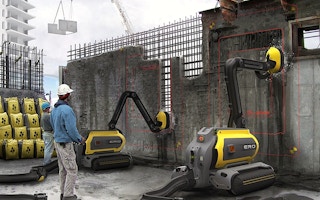Buildings are meant to be strong structures, long lasting and resistant to environmental conditions. But the strength of a building is also its weakest link sustainably, due to the amount of resources used and waste generated when suddenly replaced with a newer building. Enter ERO, the concrete recycling robot, which recently garnered Gold in the Student Designs category of the 2013 International Design Excellence Awards in the United States.
Omer Haciomeroglu, a student from the Umea Institute of Design in Sweden, designed the ERO robot. A cross between a heavy-duty vacuum cleaner and the typical yellow-and-black construction machines, ERO serves to “disassemble reinforced concrete structures and enable the building materials to be re-used for new pre-fabricated concrete buildings,” according to the designer.
In his website, he wrote: “Current techniques of concrete demolition requires a lot of power crushing, separation and machinery. Not to mention waste of water in order to prevent dust pollution during operation.” He also added that the transfer of waste material to recycling plants outside the city takes time and energy, but with only minimal recycling results.
In Singapore, a country with a booming property market, construction debris is the second most waste generated in 2012, based on data from the National Environment Agency (NEA). This is a slight increase from 2011 when it placed at third or 17 per cent of 6.9 million tonnes of waste.
Still, the country does recycle waste, although construction debris fell from first place in types of waste recycled in 2011 to second place in 2012.
Haciomeroglu plans to change the practice with ERO. Instead of manually controlled demolition equipment that smashes and pulverizes a building, with water sprayed to reduce dust pollution, he simplified the arduous process and made it efficient and sustainable.
ERO uses omnicrawler technology from Osaka University to enable its all-around movement and hydro-demolition and centrifugal decanter technologies for the high-pressure water jets that substitute for the “hydraulic brute force” and the mechanism that separates solid particles from the liquid, respectively.
He explained: “An autonomous fleet of ERO is placed strategically within the building. They scan the environment and determine a route with which they will execute the operation. Once ERO starts working, it literally erases the building. ERO de-constructs with water, sucks and separates the mixture of aggregate, cement and water. Then sends aggregate and filtered cement slurry separately down to the packaging unit to be contained.”
The outcome is clean aggregate packed into labelled bags that can be turned over to concrete pre-cast stations, finished Haciomeroglu.
The rebars are also preserved and cleanly separated from the concrete that once was meshed with it to hold the building together. These rebars can now be reused as well.
Another sustainable feature of ERO is the water function, which not only supplies the jet spray but also recycles the water back into the system. There is also the turbulence dynamos in the air suction of the packaging unit that produces a certain amount of power that enables ERO to use less energy.
“Every bit of the load-bearing structure is ready to be re-used for new building blocks,” Haciomeroglu said.

















